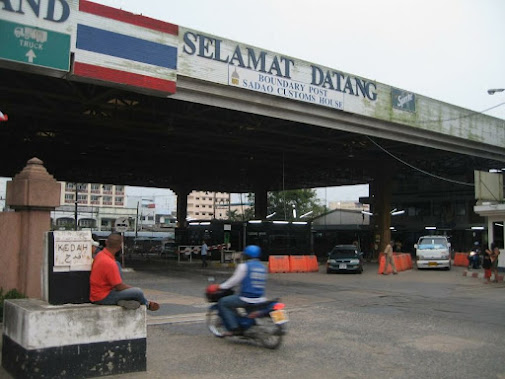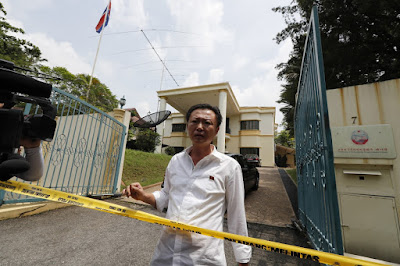The Helmeted Hornbill is still thriving in Thailand's south
Almost extinct in Indonesia and Malaysia, the Helmeted Hornbill is still thriving in Thailand's south, but for how long?
.
THE ICONIC helmeted hornbill (rhinoplax vigil), one of the most gigantic
and spectacular of Asia's 30 species of hornbills, is in grave danger
of extinction according to BirdLife International and the International
Union for Conservation of Nature (IUCN) who upgraded its threat status
to critically endangered last November.
.
All hornbills are charismatic, mainly frugivorous (fruit-eating) forest
birds of tropical forests, who take their name from the large
ornamental casques on their bills, which differ in size and shape among
species. The helmeted hornbill (known as Nok Chon Hin in Thai) is
special, though, because unlike the other hornbills, the casque is not
hollow but solid and bony.
.
Casques of the helmeted hornbill have long been sought after by Chinese
craftsmen, who carve this so-called "hornbill ivory" or "red ivory"
into elaborate ornaments and snuff-boxes. Even as long as 2,000 years
ago native peoples of Borneo were already fashioning helmeted hornbill
casques into ear-pendants and toggles. But Japan and China are the major
consumers of helmeted hornbills casques, demand for which has suddenly
and inexplicably escalated, threatening the future of this unique
species.
.
"In 2013 about 500 adult helmeted hornbills were killed each month, or
some 6,000 birds in one year, and that was only in West Kalimantan,"
laments Yokyok Hadiprakarsa of the Indonesian Hornbill Conservation
Society.
.
According to Hadiprakarsa, who also works with the Wildlife
Conservation Society (WCS) in West Kalimantan, and who has interviewed
many villagers, foresters and officials, only 1,111 helmeted hornbill
heads were confiscated by the Indonesian authorities between 2012-2014,
and eight Chinese traders, along with two Indonesian citizens, arrested.
.
The helmeted hornbill heads were being smuggled to major ports in Sumatra, Java and onwards to Hong Kong and Taiwan.
.
Such a high level of exploitation is clearly unsustainable and, if left
unchecked, will quickly drive remaining helmeted hornbill populations
to extinction.
.
Dr Nigel J Collar of BirdLife International is an expert on these
larger hornbills, noting that they have specific nesting requirements,
choosing the largest living trees with nest holes topped with a perch
for the male to use while provisioning the female.
.
During the breeding cycle, the female remains incarcerated in the nest
cavity for 160 days, when both she and the nestling are dependent solely
on food delivered by the male. Hunting during the breeding season
therefore has an especially severe impact, causing the death of the
nestling and compromising the survival of the female too.
.
Rates of forest loss in the Sundaic lowlands of Malaysia and Indonesia
remain extremely high, owing partly to the escalation of illegal logging
and conversion of forest land to rubber and oil-palm. Such habitat loss
has already caused a massive reduction in hornbill numbers. Even inside
protected areas, the best remaining stands of valuable timber may be
targeted for logging.
.
Forest fires have also had a damaging effect.The helmeted hornbill has
apparently almost disappeared from habitats where it was previously
abundant in Sumatra, Indonesia, and is equally threatened in both the
Indonesian and Malaysian parts of Borneo. It is still widespread in
protected areas in Thailand's southern provinces, which together support
six of the country's 13 species including the helmeted hornbill.
.
But even here populations of the helmeted hornbill are small and
fragmented as so little of their ancestral forest habitat remains as
national park and wildlife sanctuary, and all hornbills remain
vulnerable to hunting, and theft of chicks for the illegal pet trade.
.
The Hornbill Research Foundation of Mahidol University, Thailand, led
by Prof Pilai Poonswad and her team, has done much to raise the profile
of hornbills in this country, conducting long-term term ecological
studies
.
while monitoring populations of all hornbills in Thailand since 1978.
.
The foundation has studied the breeding ecology of the helmeted
hornbill at Budo-Sungai Padi National Park and worked with villagers in
the provinces of Pattani, Yala and Narathiwat to organise a Hornbill
Family Adoption Programme, under which for US$150 (Bt5,250) per year the
same villagers who formerly collected hornbill chicks are employed
instead as nest-guardians.
.
Records sent to Bird Conservation Society of Thailand (BCST), the Thai
partner of BirdLife International, by birdwatchers over the past few
decades show that helmeted hornbills survive today only in the largest
areas already protected as National Parks or Wildlife Sanctuaries.
.
It will take all the resources of the government's Department of
National Parks, Wildlife and Plants Conservation (DNP) to keep these
safe from poachers. A Helmeted Hornbill Task Force established through
international cooperation among SE Asian BirdLife Partners -
BCST-Birdlife Thailand; the Biodiversity and Nature Conservation
Association of Myanmar; the Malaysian Nature Society, Nature Society
(Singapore) and Burung Indonesia - to alert, and provide technical
support for, government agencies in their respective countries could
help coordinate action to safeguard helmeted hornbill.
.
Because of its relatively advanced capacity and knowledge, and good
public awareness, Thailand is perhaps well placed to lead the way with
its own a national action plan for the helmeted hornbill. The key
government agencies, besides DNP, include the Customs Department, the
Thai secretariat of the Convention on International Trade in Endangered
Species of Wild Fauna and Flora (Cites) and the Office of Natural
Resources and Environmental Policy and Planning (Onep).
.
With timely and appropriate action, there is every hope that Thai
populations of the helmeted hornbill in southern Thailand will not
follow the Gurneys Pitta into extinction, but will be sustained, and
even recover, as have populations of some other endangered vertebrates,
such as gaur and banteng in a few, favoured protected areas of the
western forest complex.
.
A DISAPPEARING FOREST GIANT
.
- The Helmeted hornbill is among the largest of Asian hornbills, about
110-120 cm long with a wingspan up to 2 metres Its plumage is patterned
blackish- brown and white, with elongate white central tail feathers
bearing a black band. The skin of the bare neck is red in the male, and
pale turquoise in the female Its distinctive high red casque, yellow at
the front and weighing about 300g, is the "helmet" of the common name.
.
- Helmeted hornbills are confined to lowland forests, from southern
Myanmar, southern Thailand, Malaysia, Singapore, Brunei and Indonesia -
the Sunda Region. They inhabit mature evergreen lowland forest, and
though recorded up to 1,500 metres above sea level, are mostly confined
to lower elevations.
.
- The call of helmeted hornbill is utterly unique -once heard never
forgotten. It is a series of loud, intermittent barbet-like hoots,
sometimes double-toned and over two dozen in number, which gradually
accelerates to culminate in a cackle reminiscent of laughter. Its unique
casque is used in rarely seen aerial jousts in which two male birds fly
from a treetop in opposite directions, circle round and swoop at each
other, cracking their casques together in mid-air in a spectacular
contest for supremacy.
.
- Hornbills are important bio-indicators of good quality forest and,
indeed, help maintain plant diversity and forest cover through their
role as seed dispersers. They are the largest fruit-eating birds in the
forest canopy, consuming the fruits of more than 200 tree species,
including not only figs but lipid-rich fruits, regurgitating and
defecating their seeds far and wide, at great distances from the parent
tree. Their role in maintaining the forest ecosystem is so immense that
they are regarded as farmers of the forest and one hornbill may plant
more than 500,000 trees in its lifetime. They are also predators of
small animals including squirrels, snakes, and other birds including
even the chicks of their own or other hornbill species, and can live
more than 30 years.
Source: The Nation









